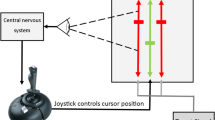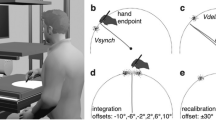Abstract
We investigated the relative importance of vision and proprioception in estimating target and hand locations in a dynamic environment. Subjects performed a position estimation task in which a target moved horizontally on a screen at a constant velocity and then disappeared. They were asked to estimate the position of the invisible target under two conditions: passively observing and manually tracking. The tracking trials included three visual conditions with a cursor representing the hand position: always visible, disappearing simultaneously with target disappearance, and always invisible. The target’s invisible displacement was systematically underestimated during passive observation. In active conditions, tracking with the visible cursor significantly decreased the extent of underestimation. Tracking of the invisible target became much more accurate under this condition and was not affected by cursor disappearance. In a second experiment, subjects were asked to judge the position of their unseen hand instead of the target during tracking movements. Invisible hand displacements were also underestimated when compared with the actual displacement. Continuous or brief presentation of the cursor reduced the extent of underestimation. These results suggest that vision–proprioception interactions are critical for representing exact target–hand spatial relationships, and that such sensorimotor representation of hand kinematics serves a cognitive function in predicting target position. We propose a hypothesis that the central nervous system can utilize information derived from proprioception and/or efference copy for sensorimotor prediction of dynamic target and hand positions, but that effective use of this information for conscious estimation requires that it be presented in a form that corresponds to that used for the estimations.






Similar content being viewed by others
References
Assad JA, Maunsell JH (1995) Neuronal correlates of inferred motion in primate posterior parietal cortex. Nature 373:518–521
Baker CI, Keysers C, Jellema T, Wicker B, Perrett DI (2001) Neuronal representation of disappearing and hidden objects in temporal cortex of the macaque. Exp Brain Res 140:375–381
Barnes GR, Asselman PT (1991) The mechanism of prediction in human smooth pursuit eye movements. J Physiol 439:439–461
Becker W, Fuchs AF (1985) Prediction in the oculomotor system: smooth pursuit during transient disappearance of a visual target. Exp Brain Res 57:562–575
Bennett SJ, Barnes GR (2003) Human ocular pursuit during the transient disappearance of a visual target. J Neurophysiol 90:2504–2520
Burke MR, Barnes GR (2007) Sequence learning in two-dimensional smooth pursuit eye movements in humans. J Vis 7:5
Carrozzo M, McIntyre J, Zago M, Lacquaniti F (1999) Viewer-centered and body-centered frames of reference in direct visuomotor transformations. Exp Brain Res 129:201–210
Cavallo V, Laurent M (1988) Visual information and skill level in time-to-collision estimation. Perception 17:623–632
Cerminara NL, Apps R, Marple-Horvat DE (2009) An internal model of a moving visual target in the lateral cerebellum. J Physiol 587:429–442
Collins CJ, Barnes GR (2005) Scaling of smooth anticipatory eye velocity in response to sequences of discrete target movements in humans. Exp Brain Res 167:404–413
De Lucia PR, Liddell GW (1998) Cognitive motion extrapolation and cognitive clocking in prediction motion task. J Exp Psychol Hum Percept Perform 24:901–914
Desmurget M, Rossetti Y, Prablanc C, Stelmach GE, Jeannerod M (1995) Representation of hand position prior to movement and motor variability. Can J Physiol Pharmacol 73:262–272
Filion CM, Washburn DA, Gulledge JP (1996) Can monkeys (Macaca mulatta) represent invisible displacement? J Comp Psychol 110:386–395
Gauthier GM, Hofferer JM (1976) Eye tracking of self-moved targets in the absence of vision. Exp Brain Res 26:121–139
Gauthier GM, Mussa Ivaldi F (1988) Oculo-manual tracking of visual targets in monkey: role of the arm afferent information in the control of arm and eye movements. Exp Brain Res 73:138–154
Gauthier GM, Vercher JL, Mussa Ivaldi F, Marchetti E (1988) Oculo-manual tracking of visual targets: control learning, coordination control and coordination model. Exp Brain Res 73:127–137
Ghez C, Gordon J, Ghilardi MF (1995) Impairments of reaching movements in patients without proprioception. II. Effects of visual information on accuracy. J Neurophysiol 73:361–372
Gooey K, Bradfield O, Talbot J, Morgan DL, Proske U (2000) Effects of body orientation, load and vibration on sensing position and movement at the human elbow joint. Exp Brain Res 133:340–348
Gray R, Thornton IM (2001) Exploring the link between time to collision and representational momentum. Perception 30:1007–1022
Hocherman S (1993) Proprioceptive guidance and motor planning of reaching movements to unseen targets. Exp Brain Res 95:349–358
Jellema T, Perrett DI (2003) Perceptual history influences neural responses to face and body postures. J Cogn Neurosci 15:961–971
Jordan S (1970) Ocular pursuit movement as a function of visual and proprioceptive stimulation. Vis Res 10:775–780
Kahneman D (1973) Attention and effort. Prentice-Hall, New Jersey
Krauzlis RJ, Lisberger SG (1994) Temporal properties of visual motion signals for the initiation of smooth pursuit eye movements in monkeys. J Neurophysiol 72:150–162
Liu X, Tubbesing SA, Aziz TZ, Miall RC, Stein JF (1999) Effects of visual feedback on manual tracking and action tremor in Parkinson’s disease. Exp Brain Res 129:477–481
Lyon DR, Waag WL (1995) Time course of visual extrapolation accuracy. Acta Psychol (Amst) 89:239–260
McIntyre J, Stratta F, Lacquaniti F (1997) Viewer-centered frame of reference for pointing to memorized targets in three-dimensional space. J Neurophysiol 78:1601–1618
McIntyre J, Stratta F, Lacquaniti F (1998) Short-term memory for reaching to visual targets: psychophysical evidence for body-centered reference frames. J Neurosci 18:8423–8435
McLeod RW, Ross HE (1983) Optic-flow and cognitive factors in time-to-collision estimates. Perception 12:417–423
Miall RC, Jackson JK (2006) Adaptation to visual feedback delays in manual tracking: evidence against the Smith Predictor model of human visually guided action. Exp Brain Res 172:77–84
Miall RC, Weir DJ, Stein JF (1993) Intermittency in human manual tracking tasks. J Mot Behav 25:53–63
Mitrani L, Dimitrov G (1978) Pursuit eye movements of a disappearing moving target. Vis Res 18:537–539
Navon D, Gopher D (1979) On the economy of the human-processing system. Psychol Rev 86:214–255
Reed DW, Liu X, Miall RC (2003) On-line feedback control of human visually guided slow ramp tracking: effects of spatial separation of visual cues. Neurosci Lett 338:209–212
Regan D (1997) Visual factors in hitting and catching. J Sports Sci 15:533–558
Robinson DA, Gordon JL, Gordon SE (1986) A model of the smooth pursuit eye movement system. Biol Cybern 55:43–57
Rosenbaum DA (1975) Perception and extrapolation of velocity and acceleration. J Exp Psychol Hum Percept Perform 1:395–403
Rossetti Y (1998) Implicit short-lived motor representations of space in brain damaged and healthy subjects. Conscious Cogn 7:520–558
Rossetti Y, Desmurget M, Prablanc C (1995) Vectorial coding of movement; vision, proprioception or both. J Neurophysiol 74:457–463
Schiff W, Detwiler ML (1979) Information used in judging impending collision. Perception 8:647–658
Smeets JB, van den Dobbelsteen JJ, de Grave DD, van Beers RJ, Brenner E (2006) Sensory integration does not lead to sensory calibration. Proc Natl Acad Sci USA 103:18781–18786
Soechting JF, Flanders M (1989a) Errors in pointing are due to approximations in sensorimotor transformations. J Neurophysiol 62:595–608
Soechting JF, Flanders M (1989b) Sensorimotor representations for pointing to targets in three-dimensional space. J Neurophysiol 62:582–594
Steinbach MJ, Held R (1968) Eye tracking of observer-generated target movements. Science 161:187–188
Takeichi M, Fujita K, Tanaka H (2004) Analysis of human anticipation property of free-falling object position using virtual environment. Trans Virtual Real Soc Jpn 9:299–308 (in Japanese)
van Beers RJ, Sittig AC, Denier van der Gon JJ (1996) How humans combine simultaneous proprioceptive and visual position information. Exp Brain Res 111:253–261
Van Horn MR (2009) Tracking an invisible target reveals spatial tuning of neurons in the rostral superior colliculus is not dependent on visual stimuli. J Neurosci 29:589–590
Vercher JL, Sares F, Blouin J, Bourdin C, Gauthier G (2003) Role of sensory information in updating internal models of the effector during arm tracking. Prog Brain Res 142:203–222
Vindras P, Desmurget M, Prablanc C, Viviani P (1998) Pointing errors reflect biases in the perception of the initial hand position. J Neurophysiol 79:3290–3294
Wexler M, Klam F (2001) Movement prediction and movement production. J Exp Psychol Hum Percept Perform 27:48–64
Wolpert DM, Ghahramani Z (2000) Computational principles of movement neuroscience. Nat Neurosci 3(Suppl):1212–1217
Acknowledgments
This work was supported by a Grant-in-Aid for Scientific Research from the Japan Society for the Promotion of Science (#17500394).
Author information
Authors and Affiliations
Corresponding author
Rights and permissions
About this article
Cite this article
Tanaka, H., Worringham, C. & Kerr, G. Contributions of vision–proprioception interactions to the estimation of time-varying hand and target locations. Exp Brain Res 195, 371–382 (2009). https://doi.org/10.1007/s00221-009-1798-1
Received:
Accepted:
Published:
Issue Date:
DOI: https://doi.org/10.1007/s00221-009-1798-1




